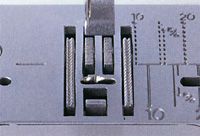 |
| quilting fabrics |
 |
| One side of the Quilt Barn. |
The Quilt barn brought back some of those memories as I looked at Lone Stars, Log Cabins, Flying Geese, among others. While some were hand quilted, and others machine stitched, seeing them all on display in one large area created a visually stimulating assortment of colors and fabrics. Nostalgia filled my lungs as I took a deep breath and sighed. Wasn't it only yesterday I was a kid wielding scissors, and straightening bolts of fabric?
The following day, we cleaned up the room, eradicating all traces of screen printing. After which, we had to set up our sewing machines and work spaces. Now, it was time to get down to business.
 |
| The studio |
 |
| Making patches |
 |
| Machine stitched applique |
| I used to live by this stuff to make custom patches for my jeans. |
Last, we learned about products such as Heat and Bond, a product that allows a anyone to attach fabric to fabric, much like a patch one would buy to fix a hole in a pair of jeans. The product is ironed on to the back of the material, after which, the sewer can cut out any shape imaginable. Peel off the paper backing, and then iron the shape onto another piece of cloth. It's that easy. Finally, it was time to put all these methods into action and play! I put two pieces of material together and just began running my machine stitches all over the front, trying to get the feel of my machine.
Now, I have two confessions to make: one, I am a partially self-taught seamstress. Rebekah (my mother) taught me the basics, and taught me well. But for whatever reason, probably my overflowing over-commited teenager schedule, we never moved beyond those basics. So, the rest of my sewing knowledge has come from me doing whatever worked, and most of the time, it's probably been the wrong way to work. Confession Number Two: I've owned my machine for twenty years, at least, and I learned how to operate it better in one week of classes than I ever did in all the years I've owned it. I'm almost embarrassed to admit it. What did I learn? Well, for one, I found out my feed dogs can be dropped.
 |
| Inside Don Kauffman's Sewing Machines |
"Do your feed dogs drop?"
"I don't think so," I said.
"Well, is it a free-arm machine?" he asked
"Um, I don't think so, " I repeated.
"Can you take something off or drop something down on your machine to help you sew pant legs?" He asked.
"Oh HEY! I CAN do that!" I said.
"That's a free-arm machine," he said, patiently.
I probably turned twenty shades of crimson. So this is the second thing I learned: what exactly is a free armed machine. I had never known. Now I do, and I feel smarter armed with this information.
 |
| feed dogs |
I could hardly wait to get back to class. I HAD to see if my feed dogs dropped. Lo and Behold, with great rejoicing and angelic music ringing through my head, I found the switch and dropped my feed dogs. I did a poor imitation of the butter churn, and might have danced a little off-rhythym jig. Just maybe.
Why did this excite me so much? Because I was no longer constrained to straight lines, corners, and gentle curves. The feed dogs are the metal 'tracks' on the bottom of the machine that feeds the cloth through while the needle jumps up and down. They keep the stitches even, and the fabric moving. Why would I want to drop the feed dogs? Because if I want to do any kind of free-form stitching, it's necessary to take away the mechanism that controls the movement of the material. I want to control the fabric.
| free-motion foot |
Now came the hardest part of the course. What, of my lovely hand-made fabrics was I willing to cut into? Oh the heart-wrenching decisions. How could I willingly hack into one of my precious pieces of printed cloth? But that's another post for another day...
~melanie

No comments:
Post a Comment